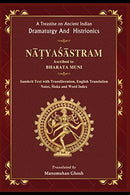The Harappan dancing girl sculpture shows, how old is the tradition of Natya viz. dance, drama and music in India. Samaveda is dedicated primarily to music; this again shows the importance of performing arts in ancient India. With such a rich legacy of dance, drama and music, India has given various great scriptures of this tradition to the world. The Natya sastra is such a scripture only. This scripture had been accepted as fifth Veda, as the same is gist of Vedas. According to scripture itself, "The recitative (pathya) he took from the Rgveda, the song from the Samaveda, the Histrionic Representation (abhinaya) from the Yajurveda and Sentiments (rasa) from the Atharvaveda and thus was created the Natyaveda.
With thirty-six chapters and over six thousand verses, this is encyclopaedia of Natya Vidya (Vidya of dance, drama and music). This comprises of every single aspect of Natya viz. it talks about the issues related literary constructions, set up of stage, details related to musical scales and murcchas, analysis of dance forms which considers several body gestures or mudras and movements along with their impact on viewers, it also educates the viewers about the etiquettes to be followed while watching a performance and it deals with Rasas.
Bharata muni describes 15 types of drama ranging from one to ten acts. Individual chapters deal with aspects such as makeup, costume, acting and directing etc.
With detailed theory of drama, Natyasastra is comparable to the Poetics of Aristotle. Bharata Muni refers to bhavas, the imitations of emotions, as per him eight principal rasas are srngara rasa (love), karunya rasa (pity), Raudra rasa (fury), Vibhatsa rasa (disgust), Vira rasa (heroism), Adbhuta rasa (wond
With thirty-six chapters and over six thousand verses, this is encyclopaedia of Natya Vidya (Vidya of dance, drama and music). This comprises of every single aspect of Natya viz. it talks about the issues related literary constructions, set up of stage, details related to musical scales and murcchas, analysis of dance forms which considers several body gestures or mudras and movements along with their impact on viewers, it also educates the viewers about the etiquettes to be followed while watching a performance and it deals with Rasas.
Bharata muni describes 15 types of drama ranging from one to ten acts. Individual chapters deal with aspects such as makeup, costume, acting and directing etc.
With detailed theory of drama, Natyasastra is comparable to the Poetics of Aristotle. Bharata Muni refers to bhavas, the imitations of emotions, as per him eight principal rasas are srngara rasa (love), karunya rasa (pity), Raudra rasa (fury), Vibhatsa rasa (disgust), Vira rasa (heroism), Adbhuta rasa (wond
Description
The Harappan dancing girl sculpture shows, how old is the tradition of Natya viz. dance, drama and music in India. Samaveda is dedicated primarily to music; this again shows the importance of performing arts in ancient India. With such a rich legacy of dance, drama and music, India has given various great scriptures of this tradition to the world. The Natya sastra is such a scripture only. This scripture had been accepted as fifth Veda, as the same is gist of Vedas. According to scripture itself, "The recitative (pathya) he took from the Rgveda, the song from the Samaveda, the Histrionic Representation (abhinaya) from the Yajurveda and Sentiments (rasa) from the Atharvaveda and thus was created the Natyaveda.
With thirty-six chapters and over six thousand verses, this is encyclopaedia of Natya Vidya (Vidya of dance, drama and music). This comprises of every single aspect of Natya viz. it talks about the issues related literary constructions, set up of stage, details related to musical scales and murcchas, analysis of dance forms which considers several body gestures or mudras and movements along with their impact on viewers, it also educates the viewers about the etiquettes to be followed while watching a performance and it deals with Rasas.
Bharata muni describes 15 types of drama ranging from one to ten acts. Individual chapters deal with aspects such as makeup, costume, acting and directing etc.
With detailed theory of drama, Natyasastra is comparable to the Poetics of Aristotle. Bharata Muni refers to bhavas, the imitations of emotions, as per him eight principal rasas are srngara rasa (love), karunya rasa (pity), Raudra rasa (fury), Vibhatsa rasa (disgust), Vira rasa (heroism), Adbhuta rasa (wond
With thirty-six chapters and over six thousand verses, this is encyclopaedia of Natya Vidya (Vidya of dance, drama and music). This comprises of every single aspect of Natya viz. it talks about the issues related literary constructions, set up of stage, details related to musical scales and murcchas, analysis of dance forms which considers several body gestures or mudras and movements along with their impact on viewers, it also educates the viewers about the etiquettes to be followed while watching a performance and it deals with Rasas.
Bharata muni describes 15 types of drama ranging from one to ten acts. Individual chapters deal with aspects such as makeup, costume, acting and directing etc.
With detailed theory of drama, Natyasastra is comparable to the Poetics of Aristotle. Bharata Muni refers to bhavas, the imitations of emotions, as per him eight principal rasas are srngara rasa (love), karunya rasa (pity), Raudra rasa (fury), Vibhatsa rasa (disgust), Vira rasa (heroism), Adbhuta rasa (wond
Payment & Security
Your payment information is processed securely. We do not store credit card details nor have access to your credit card information.


